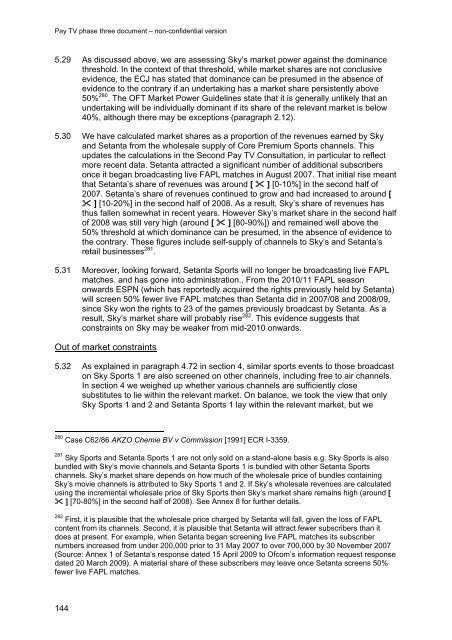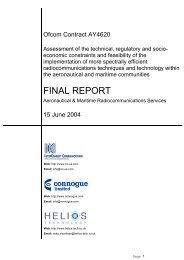Pay TV phase three document - Stakeholders - Ofcom
Pay TV phase three document - Stakeholders - Ofcom
Pay TV phase three document - Stakeholders - Ofcom
Create successful ePaper yourself
Turn your PDF publications into a flip-book with our unique Google optimized e-Paper software.
<strong>Pay</strong> <strong>TV</strong> <strong>phase</strong> <strong>three</strong> <strong>document</strong> – non-confidential version<br />
5.29 As discussed above, we are assessing Sky’s market power against the dominance<br />
threshold. In the context of that threshold, while market shares are not conclusive<br />
evidence, the ECJ has stated that dominance can be presumed in the absence of<br />
evidence to the contrary if an undertaking has a market share persistently above<br />
50% 280 . The OFT Market Power Guidelines state that it is generally unlikely that an<br />
undertaking will be individually dominant if its share of the relevant market is below<br />
40%, although there may be exceptions (paragraph 2.12).<br />
5.30 We have calculated market shares as a proportion of the revenues earned by Sky<br />
and Setanta from the wholesale supply of Core Premium Sports channels. This<br />
updates the calculations in the Second <strong>Pay</strong> <strong>TV</strong> Consultation, in particular to reflect<br />
more recent data. Setanta attracted a significant number of additional subscribers<br />
once it began broadcasting live FAPL matches in August 2007. That initial rise meant<br />
that Setanta’s share of revenues was around [ � ] [0-10%] in the second half of<br />
2007. Setanta’s share of revenues continued to grow and had increased to around [<br />
� ] [10-20%] in the second half of 2008. As a result, Sky’s share of revenues has<br />
thus fallen somewhat in recent years. However Sky’s market share in the second half<br />
of 2008 was still very high (around [ � ] [80-90%]) and remained well above the<br />
50% threshold at which dominance can be presumed, in the absence of evidence to<br />
the contrary. These figures include self-supply of channels to Sky’s and Setanta’s<br />
retail businesses 281 .<br />
5.31 Moreover, looking forward, Setanta Sports will no longer be broadcasting live FAPL<br />
matches. and has gone into administration.. From the 2010/11 FAPL season<br />
onwards ESPN (which has reportedly acquired the rights previously held by Setanta)<br />
will screen 50% fewer live FAPL matches than Setanta did in 2007/08 and 2008/09,<br />
since Sky won the rights to 23 of the games previously broadcast by Setanta. As a<br />
result, Sky’s market share will probably rise 282 . This evidence suggests that<br />
constraints on Sky may be weaker from mid-2010 onwards.<br />
Out of market constraints<br />
5.32 As explained in paragraph 4.72 in section 4, similar sports events to those broadcast<br />
on Sky Sports 1 are also screened on other channels, including free to air channels.<br />
In section 4 we weighed up whether various channels are sufficiently close<br />
substitutes to lie within the relevant market. On balance, we took the view that only<br />
Sky Sports 1 and 2 and Setanta Sports 1 lay within the relevant market, but we<br />
280 Case C62/86 AKZO Chemie BV v Commission [1991] ECR I-3359.<br />
281 Sky Sports and Setanta Sports 1 are not only sold on a stand-alone basis e.g. Sky Sports is also<br />
bundled with Sky’s movie channels and Setanta Sports 1 is bundled with other Setanta Sports<br />
channels. Sky’s market share depends on how much of the wholesale price of bundles containing<br />
Sky’s movie channels is attributed to Sky Sports 1 and 2. If Sky’s wholesale revenues are calculated<br />
using the incremental wholesale price of Sky Sports then Sky’s market share remains high (around [<br />
� ] [70-80%] in the second half of 2008). See Annex 8 for further details.<br />
282 First, it is plausible that the wholesale price charged by Setanta will fall, given the loss of FAPL<br />
content from its channels. Second, it is plausible that Setanta will attract fewer subscribers than it<br />
does at present. For example, when Setanta began screening live FAPL matches its subscriber<br />
numbers increased from under 200,000 prior to 31 May 2007 to over 700,000 by 30 November 2007<br />
(Source: Annex 1 of Setanta’s response dated 15 April 2009 to <strong>Ofcom</strong>’s information request response<br />
dated 20 March 2009). A material share of these subscribers may leave once Setanta screens 50%<br />
fewer live FAPL matches.<br />
144
















